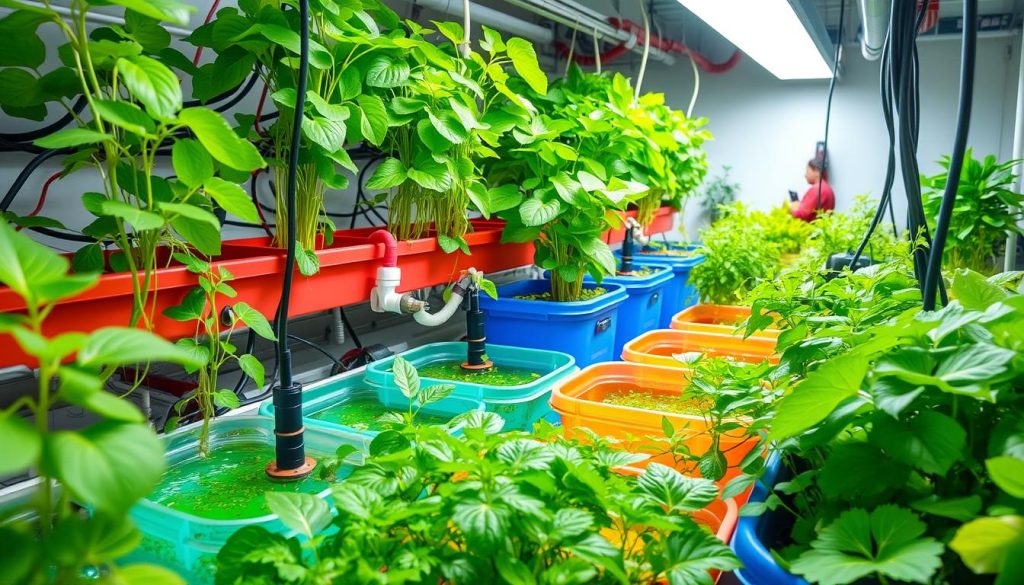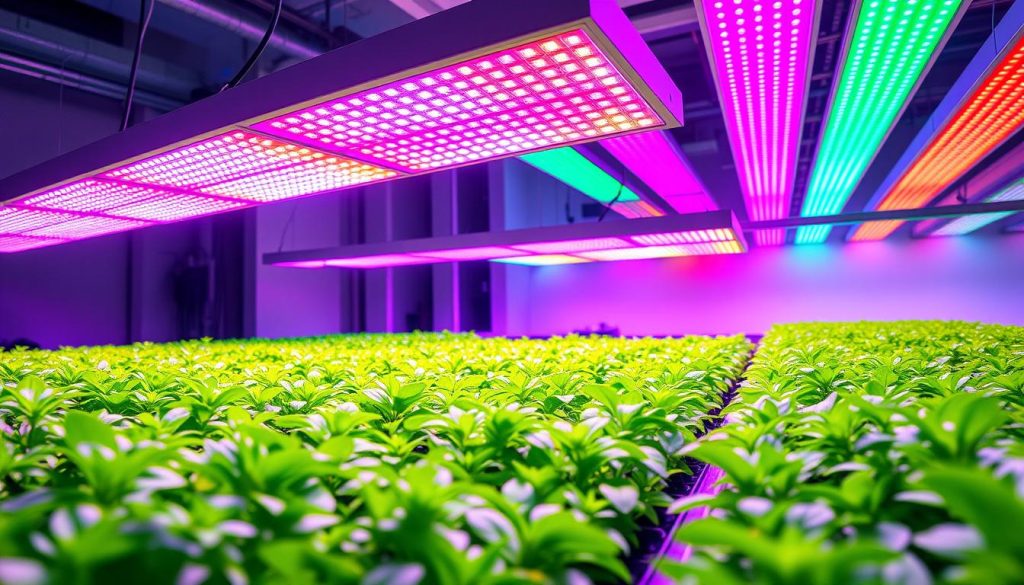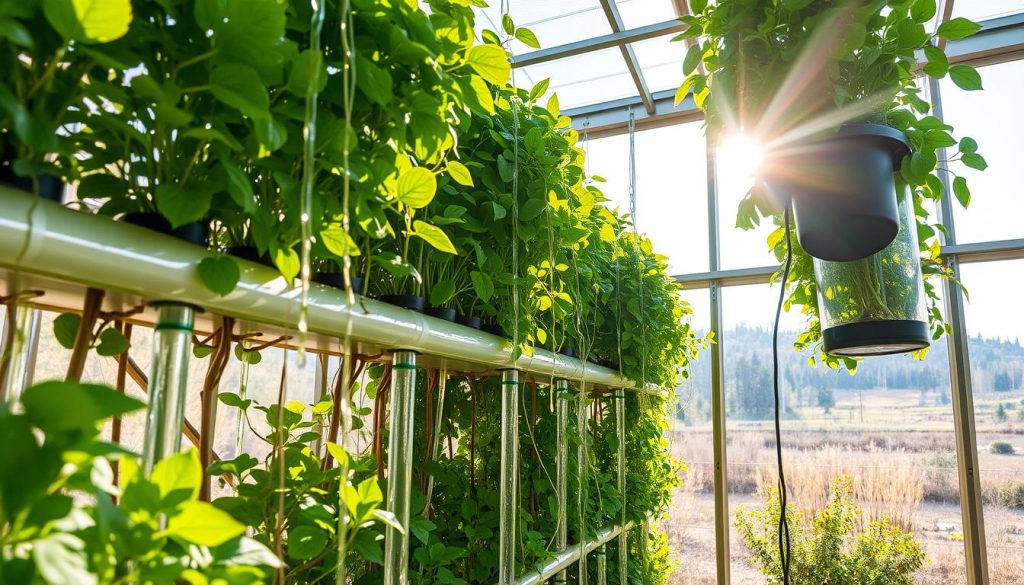In today’s world, we face big challenges like environmental issues and the need for more food. Hydroponics is a new way to garden that’s changing how we grow and eat food. It lets plants grow in water full of nutrients, not soil. This guide will take you into the world of hydroponics, covering its history, science, and benefits for gardeners everywhere.

Key Takeaways
- Hydroponics is a method of growing plants without soil, utilizing nutrient-rich water solutions.
- This soilless cultivation technique allows for year-round cultivation, increased crop yields, and efficient water usage.
- Hydroponics can be adapted for diverse environments, from deserts to urban areas, and even space stations.
- Hydroponic systems can save up to 90% of water compared to traditional soil-based gardening.
- Hydroponically grown produce can have higher levels of essential vitamins and nutrients.
What is Hydroponics: Understanding the Basics
Hydroponics is a cool way to grow plants without soil. It uses nutrient solutions to feed the roots, helping plants grow well. This method has been studied for over a century, starting with growing spearmint in water in 1699.
The Science Behind Soilless Growing
The first hydroponic systems were developed in the 1920s by Dr. W.F. Gericke from the University of California. Later, Hoagland and Arnon created a full nutrient solution in 1950. During World War II, hydroponics was used to feed American troops on Pacific islands, showing its effectiveness.
Key Components of Hydroponic Gardens
A good hydroponic garden needs a water reservoir, nutrient solutions, growing mediums, and aeration. The Deep Water Culture (DWC) system is great for small growers, keeping roots in nutrient-rich water. Popular mediums like Rockwool and Hydroton/LECA offer different benefits.
Hydroponics saves water and grows plants faster than soil-based systems. As it keeps improving, it’s set to change the future of growing plants for both hobbyists and big producers.
Benefits and Limitations of Hydroponic Gardening
Hydroponic gardening is a new way to grow plants without soil. It saves a lot of water, using up to 90% less than traditional farming. This is great for places where water is scarce.
Hydroponic systems also control nutrients and prevent soil diseases. This leads to faster growth, more yields, and better quality crops. Plus, it cuts down on pesticide use, making it better for the environment.
But, hydroponic gardening has some downsides. Starting up can be expensive, especially for big setups. It also needs a steady power supply. Any power issues can harm plant growth.
- Hydroponic farming uses significantly less water compared to conventional agriculture, making it a valuable technique for water-scarce regions.
- Hydroponics eliminates soil-borne diseases, contributing to the production of high-quality and disease-free plants.
- Hydroponic plants grow faster and achieve higher yields due to the controlled nutrient supply directly to the roots.
- Setting up a hydroponic system can be expensive, especially for large-scale operations.
- Hydroponic systems are reliant on electricity, posing a risk of system failure during power outages.
- Proper knowledge and expertise are required to operate a hydroponic system efficiently.
Despite its challenges, hydroponic gardening offers big advantages. It’s a key player in making food production more sustainable and efficient.
Essential Equipment and Materials for Hydroponics
To have a successful hydroponic garden, you need the right tools and materials. This includes reservoirs, growing containers, pumps, aeration systems, and lights. Each part is vital for plant growth and nutrient uptake. Let’s explore the key elements for a thriving hydroponic setup.
Reservoirs and Growing Containers
Hydroponic systems can be water-based or use a medium. They can also be open or closed. The size of the water basin depends on the plant size and number. Small plants need half a gallon, medium ones 1 ½ gallons, and large plants 2 ½ gallons.
Pumps and Aeration Systems
Aeration is key for plant growth and nutrient uptake in hydroponics. Air stones and pumps are crucial. They keep the nutrient solution oxygenated, helping plants thrive. These systems also prevent water stagnation, which can harm plants.
Lighting Requirements
Good lighting is essential for hydroponic gardening. Southern windows and greenhouses offer at least six hours of direct light daily for veggies. For best growth, grow lights with 4,000 to 6,000 Kelvin are suggested for hydroponics. Different plants need different light levels, so ensure proper lighting for your plants.
Choosing and maintaining the right hydroponic equipment and materials is crucial. It allows for a soil-free garden that boosts plant growth and productivity. With the correct setup, you can enjoy the perks of hydroponic gardening and grow your own fresh produce.
Types of Hydroponic Growing Systems
Hydroponics offers many growing systems, each with its own special features. These systems are great for different plants and growing conditions. The most common ones are the Nutrient Film Technique (NFT), deep water culture (DWC), and aeroponics.
The Nutrient Film Technique (NFT) is very scalable. It moves a thin film of nutrient-rich water over the plant roots. This keeps the roots supplied with what they need. NFT is best for plants with small roots, like leafy greens and herbs.
Deep water culture (DWC) systems, like the Hydrofarm 5 Gallon Hydroponic Bucket System, are very popular. They have over 1,400 reviews on Amazon. In these systems, the roots are in a nutrient-rich solution. This lets the plants absorb nutrients directly.
Aeroponics is another advanced method. It suspends the roots in the air and sprays them with a nutrient solution. This method is very efficient and saves water.
Other systems include ebb-and-flow, drip, and subirrigation. Each has its own benefits and is good for different plants and conditions. The right system depends on space, budget, and the plants you want to grow.
Hydroponic gardening has many advantages. It allows for fast growth, higher yields, and better plant quality than soil-based gardening. Knowing about the different hydroponic systems helps gardeners choose the best one. This leads to successful soil-free growing.
Selecting the Right Growing Medium
In hydroponic gardening, the growing medium is key to plant success. It must support, oxygenate, water, and nourish the plants. There are many options, each suited for different hydroponic systems.
Popular Medium Options
- Rockwool: Rockwool is the top choice for hydroponics. It helps plants grow fast, fights diseases, and holds water and air well.
- Perlite: Perlite is light and porous, great for drainage and air. It’s often mixed with coco coir or vermiculite.
- Coco coir: Coco coir is eco-friendly and keeps moisture. It also supports good bacteria growth.
- Hydroton: Hydroton, or expanded clay pellets, is reusable and drains well but holds moisture poorly.
Medium Properties and Characteristics
Choosing a growing medium depends on several factors. These include availability, cost, quality, and the hydroponic system. Each medium has its own strengths and weaknesses.
For instance, rockwool is fast and fights diseases. Perlite and coco coir are great at holding moisture and air. Knowing your plants’ needs and your system is key to picking the right medium.
Nutrient Solutions and Water Management
Keeping the nutrient solutions and water quality right is key for a hydroponic garden’s success. Nutrient solutions are made by mixing fertilizer salts in water. You can buy these solutions or make your own, based on your plants’ needs.
In closed systems, the solution is checked, adjusted, and cleaned before it goes back around. It’s important to keep the water’s pH, electrical conductivity, and dissolved oxygen levels just right. This ensures plants can absorb the nutrients they need.
- Ideal pH levels for hydroponics typically range from 5.5 to 6.5 for optimal nutrient availability.
- Electrical Conductivity (EC) and Total Dissolved Solids (TDS) measurements help determine the nutrient concentration in the water.
- Dissolved Oxygen (DO) sensors should aim for 5-7 ppm for healthy root growth and nutrient uptake.
- Oxidation-Reduction Potential (ORP) sensors should read between 200-350 mV for most hydroponic plants.
By managing the nutrient solutions and water quality well, growers can help their plants grow strong and produce lots of food. It’s important to keep checking and adjusting things to keep the hydroponic environment healthy and balanced.
Understanding pH Levels and Nutrient Uptake
Keeping the right pH levels is key for plants to absorb nutrients well in hydroponics. Most plants do best in a pH between 5.5 and 6.0. This slightly acidic range helps plants get the nutrients they need.
pH Testing Methods
There are many ways to check pH in hydroponics. Digital pH meters give precise readings. Liquid test kits and pH strips are cheaper and simpler to use. It’s good to test pH at least once a week to keep the solution balanced.
Adjusting and Maintaining Proper pH
- pH levels range from 0 to 14, with 7 being neutral. Below 7 is acidic, and above 7 is alkaline.
- To change pH, growers use “pH up” or “pH down” products. These contain chemicals like potassium hydroxide or phosphoric acid.
- Follow the maker’s instructions to slowly adjust pH to the best range of 5.5 to 6.0 for plants.
- Keep a close eye on pH levels. Changes can affect how plants absorb nutrients and their health.
By managing pH levels in hydroponics, growers help their plants get the nutrients they need. This leads to strong growth and high yields.
Plant Selection for Hydroponic Gardens
Hydroponic gardening offers a wide range of options. You can grow everything from leafy greens to juicy tomatoes and flavorful herbs. But, not all plants do well in these soil-free environments.
For beginners, leaf lettuce, herbs, and green onions are great choices. They grow easily, have quick harvest times, and handle common hydroponic problems well.
- Leaf lettuce, spinach, and kale do well in Nutrient Film Technique (NFT) systems. These systems keep the roots constantly watered.
- Deep Water Culture (DWC) systems are good for plants that need oxygen. Crops like bok choy, cucumbers, and basil love these systems.
- Flood and drain (ebb and flow) systems are versatile. They work for strawberries, tomatoes, peppers, and many herbs.
When picking plants, think about their growth rate, nutrient needs, and space requirements. Trying out different crops can help you find the best fit for your hydroponic garden. This way, you’ll get a great harvest of crops, lettuce, tomatoes, and herbs.
Light Requirements and Environmental Control
In a hydroponic setup, light is key for plant growth. The light’s intensity, how long it lasts, and its color affect how plants grow. Many use artificial grow lights to control the light better than natural sunlight.
Natural vs Artificial Lighting
Natural sunlight is great for plants, but it’s not always enough, especially indoors. Grow lights offer the right light for plants to grow well. They can be adjusted for different plants in a hydroponic environment.
Temperature and Humidity Control
Keeping the right temperature and humidity is also vital. Plants need specific conditions to grow well. You must watch and adjust air flow, heat, coolness, and moisture levels for a healthy garden.

Understanding and managing light, temperature, and humidity helps a lot. It makes your grow lights and climate control system work better. This boosts the benefits of growing plants without soil in a hydroponic environment.
Managing Plant Health and Growth
Keeping your plants healthy is key to a successful hydroponic garden. It’s important to watch for nutrient deficiencies, pH levels, and growth. By being alert and making quick changes, your plants will thrive.
Watching for nutrient deficiencies is crucial. Yellow leaves, slow growth, or color changes mean something’s off. Fixing the nutrient levels and pH helps your plants grow well.
Right environmental conditions are also vital. Good light, temperature, and air help plants grow. Pruning and training plants focus their energy, boosting your garden’s yield.
Regular checks and tweaks are vital for plant health and success. Being proactive ensures your plants get the nutrients they need. This leads to strong, healthy plants in your hydroponic garden.
- Regularly check for nutrient deficiencies, like yellow leaves or slow growth
- Adjust the nutrient solution and pH levels to fix imbalances
- Make sure plants have enough light, temperature, and air for growth
- Prune and train plants to guide their growth
- Keep a regular schedule for testing and adjusting to keep plants healthy
By being proactive and attentive, you can help your hydroponic plants reach their best. Enjoy a rich harvest from your soil-free garden.
Disease Prevention and Pest Control
Keeping your hydroponic garden healthy and thriving is key. You must watch out for common plant diseases and pests. Using Integrated Pest Management (IPM) is a smart move. It helps you manage pests and diseases by setting action thresholds, monitoring, preventing, and controlling them.
Common Hydroponic Plant Diseases
Hydroponic gardens face many diseases like root rot, gray mold, and algae. Root rot shows up as yellow leaves, droopy leaves, and brown, slimy roots. Gray mold spreads fast on plants’ surfaces, stems, and roots.
To prevent these, keep nutrient levels right, pH balanced, and the system clean. This is crucial.
Integrated Pest Management Strategies
- Check your hydroponic system often for pests like whiteflies, spider mites, thrips, and aphids.
- Use organic pest control, like insecticidal soap, to fight pests safely.
- Change the environment, like humidity, to make it hard for pests and diseases to thrive.
- Use beneficial microbes, biostimulants, and natural products to boost plant health and fight off pathogens.
- Keep up with new ways to control pests, like robotics and ultraviolet light.
With a thorough IPM plan, you can stop and manage diseases and pests in your hydroponic garden. This keeps your garden healthy and productive.
Maintenance and System Monitoring
Keeping a hydroponic garden healthy needs careful attention to key areas. It’s important to regularly clean the hydroponic system to stop algae and mineral buildup. This cleaning should happen every 2 to 6 weeks, based on how often you use it.
Also, monitoring nutrients is crucial. Check and adjust the nutrient solution’s pH and electrical conductivity (EC) often. The pH should be between 5.5 and 6.5, and EC should be 1.0 to 2.5 mS/cm. Change the nutrient solution every 1-2 weeks to avoid salt and pathogen buildup.
pH adjustments are key for plant health. Testing and adjusting pH levels helps plants absorb nutrients well. Use diluted hydrogen peroxide or vinegar to clean and adjust pH levels.
It’s also important to keep the environment right. Water should be between 65°F and 75°F, air between 70°F and 80°F, and humidity between 40% and 60%. Monitoring and adjusting these conditions helps plants grow well.
By focusing on hydroponic system cleaning, nutrient monitoring, and pH adjustments, growers can keep their systems running smoothly. This ensures the long-term success of their hydroponic gardens.
Sustainable Practices in Hydroponic Gardening
Hydroponic gardening is a big step towards sustainable agriculture. It doesn’t need soil, which cuts down on land use and environmental harm. Hydroponics can save up to 90% of water compared to old farming ways, making it very water-efficient.
Hydroponics also saves energy. Using LED grow lights and solar power makes it even greener. Plus, hydroponics control nutrients closely, reducing waste and boosting plant growth.
- Hydroponic farming can lead to crop yields that are up to 50% faster compared to traditional soil-based farming methods.
- Hydroponic systems typically require only 10% of the water used in traditional farming, showcasing high efficiency in water conservation.
- The efficient use of water and resources in hydroponics makes it a sustainable farming method with minimal environmental impact.
Recycling and proper disposal of nutrient solutions and mediums are key in hydroponic gardening. As technology improves, using seawater for coastal and desert areas could become a reality. This would help more areas grow food sustainably.

Hydroponic gardeners can help the world by using these sustainable methods. They support water and energy saving, and eco-friendly farming. As we face food and resource challenges, hydroponics can help us build a greener future.
Conclusion
Hydroponics is a promising way to grow food sustainably, even in tough places. It’s used for home gardens and could even be used in space. Starting with hydroponics might cost money and need some learning, but it offers many benefits.
These benefits include growing food all year, saving water, and getting more crops. This makes hydroponics a great choice for the future of growing food.
Soilless gardening, like hydroponics, uses water wisely and grows more food. This is why more people are turning to hydroponic technology. As we face environmental and resource issues, hydroponics is becoming even more important.
Advances in systems, nutrients, and growing methods are pushing hydroponics forward. This means we can keep finding new ways to grow food better.
If you garden at home or grow food for a living, hydroponics could change your game. It’s a way to grow food sustainably and of high quality. By using hydroponics, we can build a food system that’s safe and strong for the future.